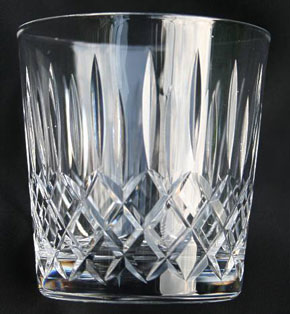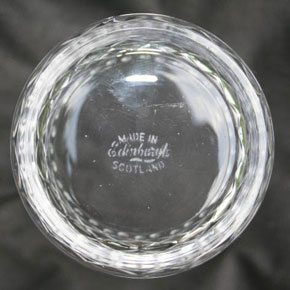Information and History
| Glass articles - Edinburgh Crystal |
Scottish Glass - Makers, Craftsmen & Artists |
|
Memories of a Side Lever Press OperatorThomas GrahamWritten by Glen ThistlewoodCopyright T. Graham and G. Thistlewood, 2007Dedication:To my lovely Brummie Mother (now aged 88), Marjory Graham, who said “yes” to my father in 1951, to come to Edinburgh, resulting in a large Graham clan in Edinburgh who love Birmingham!”Back in the hard days of the late 1930s, two young men left their home in Scotland to try and find work in the heart of England – the Black Country. The men were ex miners, one was just 21 years old, his elder brother was 24. As they trudged the banks of the Birmingham Canal by Lodge Road, they met a policeman on his beat. “What are you two doing?” he demanded. “Looking for work” was the reply. The copper raised his hand and pointed at a nearby factory –“Try in there” he suggested – and so they did. The factory was Phoenix Glass: its full name, which in fact it was almost never called, was the British Heat Resisting Glass Company. They made heatproof glass oven ware, akin to Pyrex, which was favoured during the following war years, instead of metal pots and pans. The two men were soon joined by two more brothers, and they worked there until 1946 when another glass factory – right next door to the Phoenix – asked them to join their workforce. And the name of the factory that “headhunted” the brothers? Walsh Walsh. The men in question were the father and uncle of Tommy Graham – himself a skilled glassworker and the subject of this feature. Tommy told us that his father – Tom – was part of the only pressed glass team that ever worked at Walsh Walsh. He also added that an experienced glassmaker, Wainwright, who worked at Walsh Walsh before moving to Scotland, once described Tom as the best glass gatherer he had ever seen. In 1951 Walsh Walsh closed and Tommy reports that Ken Northwood came down from Scotland to Birmingham to talk to the pressed glass team there and ask them to consider going to work at Edinburgh Crystal. If the name, Northwood, sounds familiar, that’s because it is – he was a member of the famous Northwood glassmaking family and a relation of Harry Northwood, the renowned Carnival Glass maker. Those readers who have the late William Heacock’s book on Northwood – “The Wheeling Years” will note the name in the acknowledgments, as Ken Northwood loaned some family photos. Tommy told us that he believed Ken Northwood actually had his own collection of Carnival Glass – one wonders if he only collected Northwood’s! For Tommy’s father, the enticement to return to Scotland was strong. Leaving his brothers in Birmingham, he took his wife and family to Scotland and in 1952 made the decision to stay in Edinburgh. Tommy himself was 12 at that time, and he remembers the move well. At Edinburgh Crystal, Tom Graham established a pressed glass team – in just five years time, his son Tommy would join that team. And thus, at 17 years of age, Tommy became part of the team and began to press glass, standing side by side with his father. He acknowledges the amazing skill and guidance of his father – and together they produced a huge amount of glass over the years that they worked there. The side lever press that they had used at Walsh and Walsh, was brought to Edinburgh Crystal too. Tommy describes the set up: his father would be by the clay pot which was full of hot metal (molten glass), Tommy was at his side, operating the side lever press – his father would take a half turn, gather, take a half turn and give the gather to Tommy to press. Their physical proximity to each other was something that Tommy noted in the context of a later visit he made to Newcastle where he had been offered employment at one of the glass works. He recalled noting with interest that there the glass worker gathered and then took 4 steps to reach the presser. Tommy’s father simply made that half turn. |
|
|
Illustration - whisky tumbler Pressed glass blank made at ©2007 S. Thistlewood
Glass items made on a side lever press at Edinburgh Crystal
|
On a bemused note, Tommy explained that at Edinburgh Crystal, the pressers were looked down on and were considered only “semi skilled”. It didn’t bother the pressed glass team, they just got on with their job, and clearly took great pleasure in their skills, for as Tommy says, they were good at their job. To do it, you had to be both physically and mentally alert and fully aware of everything that was going on around you. The presser depended on the skill of the gatherer to present just the right amount of hot metal – and Tommy had implicit trust in the skills and judgment of his father in that respect. In Tommy’s words, the presser “needed a deft touch – for one minute you could be making a small pin dish and the next a cigar ash tray, which was probably the heaviest piece of glass ever made on a single gather!” Edinburgh Crystal had the highest percentage of lead in their glass batch – around 331/3%, as opposed to the European standard of around 24%. It was heavy glass!
In 1971, Dema Glass took over Edinburgh Crystal and Thomas Webb. Dema’s main product was barware and Tommy recalls that the new owners felt that a pressed glass team would be very useful to them. In that same year Ken Northwood came up to break the news that stainless steel moulds would be arriving for the production of whisky tumblers in three sizes: 5 oz, 7 oz and 10 oz. The moulds were innovative! They were not open and shut moulds, but were instead a one piece mould, with the bottom of the mould dropping out (and releasing the tumbler). The tumblers were pressed as blanks, to be cut afterwards. Tommy Graham remembers how he felt when he first saw these moulds – surely there was no way a machine could make fine tableware? He recalls that the company sought permission and agreement from the rest of the glassmakers at Edinburgh Crystal to put the moulds into use, and accordingly they received that agreement. The Trial Run was eagerly anticipated – at 4pm one afternoon the entire factory stopped working and stood around to watch. And it was a disaster! Everything went wrong on that maiden run, and Tommy recalls that many of the other glass makers went away smiling at the red faces of the pressed glass team. But they were not a team of men to be underestimated – in just a few weeks they had got the hang of it all, and were turning out huge quantities of pressed glass tumblers. Soon a plain salad bowl was also being made using a stainless steel mould (not an open and shut mould). Tommy reports that this caused quite a stir in the glass industry. It was the first time ever in Britain that this had been done – 35 or so years ago – and it turned the crystal glass industry upside down. Glass blowers who had been making these items all their lives were now able to look at a pressed tumbler that was as good as if it had been blown! The big difference was in the output: the pressed glass team could turn out between 5000 and 7000 tumblers in the same time that the blowers could produce 500. Over a three year period in the early 1970s, Tommy reckons that between 700,000 and 800,000 pressed tumblers were made. In his words, it “turned the glass industry upside down”. At the end of this article, you can read a list of the glass items that Tommy and his team made on the side lever press at Edinburgh Crystal. Similar progress, of course, was being made in glass companies all over Europe. More innovation followed – though the early examples from these one piece moulds were then cut, Tommy tells us that just a few years later Dema brought in a cutting machine whereby a blank was put into the machine and it emerged cut. |
|
These changes were major, and one consequence was that the glassmakers in the Edinburgh area felt that their jobs were threatened. But Tommy notes that when he left the glass industry, some 26 or 27 years ago, other glassmakers at Edinburgh Crystal took over the press team, but they were unable to get the same high output that Tommy and his team had achieved. He told us that he had been most upset to learn a few years later that the old Walsh and Walsh side lever press he had used had been smashed up. Tommy had looked after it with care over many years – its loss was painful to him. Pressed glass manufacture on site at Edinburgh Crystal ceased – all blanks then were imported instead. Time went by, after Tommy left, and from time to time he would look at examples of glass from Edinburgh Crystal and wistfully form an opinion that they were insipid compared to that which he and his team used to produce. At Edinburgh Crystal, three wine glass blowers were kept “to appease the visitors” who wanted to see the glass being made. In reality though, much of the glass came in from Germany, Czechoslovakia and Spain to be cut on machines in Edinburgh, which allowed it to be sold as “Made in Scotland”. Tommy Graham maintained his keen interest in glass, however, and became an informed and enthusiastic collector of Carnival Glass as well as Jobling, Lalique, Sabino and Baccarat. He shares his collecting desires with many others, of course – but his memories, however, are unique. |
|
|
Footnote: The demise of Edinburgh Crystal took place in July 2006 Hamish Rutherford, in The Scotsman, explains it all very well. Jane Bradley for the Evening News in Edinburgh, July, 2006, also wrote a good account and her article contains some interesting follow up comments. Notes: Walsh Walsh 1850-1951, Lodge Road, Winson Green, Birmingham – pressed and blown glass Phoenix Glass 1934-1970 – making heatproof oven ware (British Heat Resisting Glass company) – Lodge Road, Winson Green, Birmingham Edinburgh Crystal under this name, 1955 to date, before that, Edinburgh & Leith Flint Glass This article first appeared on the web-site of authors Glen and Steve Thistlewood and is reproduced on Scotland's Glass with their consent. |
|
This page one of a series that will give brief details about people who have or are working in Scottish Glass. If you are or have worked with glass in Scotland please get in touch as I would like to feature you too! I would also like to hear from collectors with information on those glass workers who have moved on.
| ← The Story of Edinburgh Crystal (1977) | Norton Park Photographs 1 - March 1974 → |
|---|
| < Previous | Next > |
|---|
Joomla template created by Rosswerkz Studios




